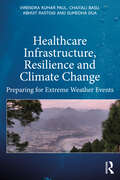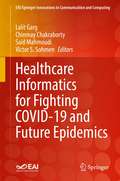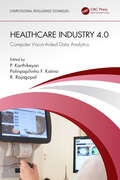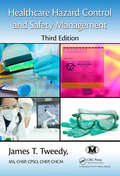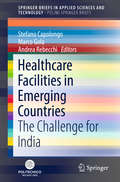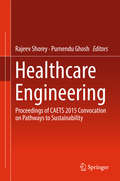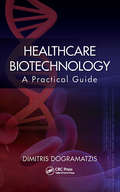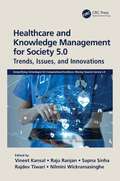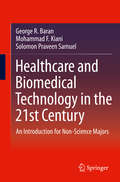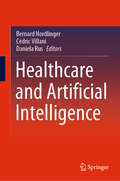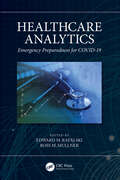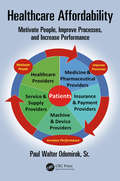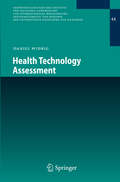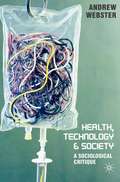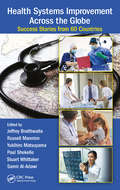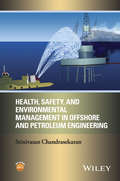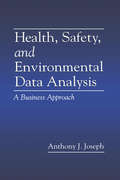- Table View
- List View
Healthcare Infrastructure, Resilience and Climate Change: Preparing for Extreme Weather Events
by Virendra Kumar Paul Abhijit Rastogi Sumedha Dua Chaitali BasuThis book highlights the vulnerability of healthcare buildings in the context of climate change-triggered extreme weather events (EWEs) and the case for mitigation. With a concise discussion on climate change and its consequences in the form of such events, a cost model and equations that register losses and help quantify them are then presented. The model can be used to estimate the significant potential loss that might occur during an EWE and help healthcare facilities prepare for them. The book analyses cases of major EWEs in India over the last two decades and collates the data available into various categories. Through this research the authors have developed a framework which assists healthcare facilities with a detailed calculation of value losses, both tangible and intangible. The framework can be used to assess the impacts on healthcare buildings in terms of disruption of services so that appropriate decisions related to the resilience in healthcare planning can be taken into consideration. Thus, the book is useful for directing planning and design processes aimed at continuity of service and building resilience to perform in the face of natural disaster and extreme weather. The purpose of this book is to prompt facilities planners and healthcare facilities to prepare to respond to EWEs through the planning and design process in a rational manner. Built infrastructure professionals such as architects and engineers, policy makers, and academics with an interest in disasters, risk and climate change will all find this book to be key reading.
Healthcare Infrastructure, Resilience and Climate Change: Preparing for Extreme Weather Events
by Virendra Kumar Paul Abhijit Rastogi Sumedha Dua Chaitali BasuThis book highlights the vulnerability of healthcare buildings in the context of climate change-triggered extreme weather events (EWEs) and the case for mitigation. With a concise discussion on climate change and its consequences in the form of such events, a cost model and equations that register losses and help quantify them are then presented. The model can be used to estimate the significant potential loss that might occur during an EWE and help healthcare facilities prepare for them. The book analyses cases of major EWEs in India over the last two decades and collates the data available into various categories. Through this research the authors have developed a framework which assists healthcare facilities with a detailed calculation of value losses, both tangible and intangible. The framework can be used to assess the impacts on healthcare buildings in terms of disruption of services so that appropriate decisions related to the resilience in healthcare planning can be taken into consideration. Thus, the book is useful for directing planning and design processes aimed at continuity of service and building resilience to perform in the face of natural disaster and extreme weather. The purpose of this book is to prompt facilities planners and healthcare facilities to prepare to respond to EWEs through the planning and design process in a rational manner. Built infrastructure professionals such as architects and engineers, policy makers, and academics with an interest in disasters, risk and climate change will all find this book to be key reading.
Healthcare Informatics for Fighting COVID-19 and Future Epidemics (EAI/Springer Innovations in Communication and Computing)
by Lalit Garg Chinmay Chakraborty Saïd Mahmoudi Victor S. SohmenThis book presents innovative solutions utilising informatics to deal with various issues related to the COVID-19 outbreak. The book offers a collection of contemporary research and development on the management of Covid-19 using health data analytics, information exchange, knowledge sharing, the Internet of Things (IoT), and the Internet of Everything (IoE)-based solutions. The book also analyses the implementation, assessment, adoption, and management of these healthcare informatics solutions to manage the pandemic and future epidemics. The book is relevant to researchers, professors, students, and professionals in informatics and related topics.
Healthcare Industry 4.0: Computer Vision-Aided Data Analytics (Computational Intelligence Techniques)
by P. Karthikeyan Polinpapilinho F. Katina R. RajagopalThis book covers computer vision-based applications in digital healthcare industry 4.0, including different computer vision techniques, image classification, image segmentations, and object detection. Various application case studies from domains such as science, engineering, and social networking are introduced, along with their architecture and how they leverage various technologies, such as edge computing and cloud computing. It also covers applications of computer vision in tumor detection, cancer detection, combating COVID-19, and patient monitoring. Features: Provides a state-of-the-art computer vision application in the digital health care industry. Reviews advances in computer vision and data science technologies for analyzing information on human function and disability. Includes practical implementation of computer vision application using recent tools and software. Explores computer vision-enabled medical/clinical data security in the cloud. Includes case studies from the leading computer vision integrated vendors like Amazon, Microsoft, IBM, and Google. This book is aimed at researchers and graduate students in bioengineering, intelligent systems, and computer science and engineering.
Healthcare Industry 4.0: Computer Vision-Aided Data Analytics (Computational Intelligence Techniques)
by P. Karthikeyan Polinpapilinho F. Katina R. RajagopalThis book covers computer vision-based applications in digital healthcare industry 4.0, including different computer vision techniques, image classification, image segmentations, and object detection. Various application case studies from domains such as science, engineering, and social networking are introduced, along with their architecture and how they leverage various technologies, such as edge computing and cloud computing. It also covers applications of computer vision in tumor detection, cancer detection, combating COVID-19, and patient monitoring. Features: Provides a state-of-the-art computer vision application in the digital health care industry. Reviews advances in computer vision and data science technologies for analyzing information on human function and disability. Includes practical implementation of computer vision application using recent tools and software. Explores computer vision-enabled medical/clinical data security in the cloud. Includes case studies from the leading computer vision integrated vendors like Amazon, Microsoft, IBM, and Google. This book is aimed at researchers and graduate students in bioengineering, intelligent systems, and computer science and engineering.
Healthcare Hazard Control and Safety Management
by James T. TweedyComprehensive in scope, this totally revamped edition of a bestseller is the ideal desk reference for anyone tasked with hazard control and safety management in the healthcare industry. Presented in an easy-to-read format, Healthcare Hazard Control and Safety Management, Third Edition examines hazard control and safety management as proactive funct
Healthcare Facilities in Emerging Countries: The Challenge for India (SpringerBriefs in Applied Sciences and Technology)
by Stefano Capolongo Marco Gola Andrea RebecchiThis multidisciplinary book brings together medical, management, and architectural disciplines in order to formulate new approaches to the programming, planning, and design of healthcare facilities that will improve the quality of healthcare systems in rapidly developing countries, respecting local culture. It achieves this aim by drawing upon case studies on healthcare facilities and services that were undertaken in Kolkata, India, where the public healthcare system is meager and most people do not have access to health services. The approaches presented pay appropriate attention to technical aspects and organizational set-up and are designed to achieve an adequate healthcare assistance, greater production efficiency, better use of local professional resources, and careful control of construction. They are also intended to promote educational progress and future independence in construction and management of the healthcare system. The book will appeal to all with an interest in design and organizational strategies to meet new healthcare challenges in India and other emerging countries.
Healthcare Engineering: Proceedings of CAETS 2015 Convocation on Pathways to Sustainability
by Rajeev Shorey Purnendu GhoshThe book contains the proceedings of CAETS 2015 Convocation on ‘Pathways to Sustainability: Energy, Mobility and Healthcare Engineering’ that was held on October 13-14, 2015 in New Delhi. This 3 volume proceedings provide an international forum for discussion and communication of engineering and technological issues of common concern. This volume talks about ‘Healthcare’ and includes 11 chapters on diverse topics like regenerative engineering, big data analytics in healthcare, molecular science, rising expenditure on health issues, adoption of personalized medicine, etc. The contents of this volume will be useful to researchers and healthcare professionals.
Healthcare Biotechnology: A Practical Guide
by Dimitris DogramatzisForeseeing and planning for all of the possibilities and pitfalls involved in bringing a biotechnology innovation from inception to widespread therapeutic use takes strong managerial skills and a solid grounding in biopharmaceutical research and development procedures. Unfortunately there has been a dearth of resources for this aspect of the field.
Healthcare Biotechnology: A Practical Guide
by Dimitris DogramatzisForeseeing and planning for all of the possibilities and pitfalls involved in bringing a biotechnology innovation from inception to widespread therapeutic use takes strong managerial skills and a solid grounding in biopharmaceutical research and development procedures. Unfortunately there has been a dearth of resources for this aspect of the field.
Healthcare and Knowledge Management for Society 5.0: Trends, Issues, and Innovations (ISSN)
by Vineet KansalHealthcare and knowledge management is the need of the era; this book investigates various challenges faced by practitioners in this area. It also covers the work to be done in the healthcare sector and the use of different computing techniques for better insight and decision-making. Healthcare and Knowledge Management for Society 5.0: Trends, Issues, and Innovations showcases the benefits of computing techniques used for knowledge management in the field of healthcare in the futuristic perspective of having a human-centric society 5.0. The book includes topics related to the use of technologies like artificial intelligence, machine learning, deep learning, Internet of Things, blockchain, and sensors for effective healthcare and management. Case studies are included for easy comprehension and the book covers the most up-to-date research in the field. The use of techniques like artificial intelligence in the field of knowledge management is also discussed.This book is intended for researchers and academicians to explore new ideas, techniques, and tools. Researchers working in interdisciplinary research can also find many interesting topics which will pave the way for a new arena in healthcare and knowledge management.
Healthcare and Knowledge Management for Society 5.0: Trends, Issues, and Innovations (ISSN)
by Vineet Kansal Raju Ranjan Sapna Sinha Rajdev Tiwari Nilmini WickramasingheHealthcare and knowledge management is the need of the era; this book investigates various challenges faced by practitioners in this area. It also covers the work to be done in the healthcare sector and the use of different computing techniques for better insight and decision-making. Healthcare and Knowledge Management for Society 5.0: Trends, Issues, and Innovations showcases the benefits of computing techniques used for knowledge management in the field of healthcare in the futuristic perspective of having a human-centric society 5.0. The book includes topics related to the use of technologies like artificial intelligence, machine learning, deep learning, Internet of Things, blockchain, and sensors for effective healthcare and management. Case studies are included for easy comprehension and the book covers the most up-to-date research in the field. The use of techniques like artificial intelligence in the field of knowledge management is also discussed.This book is intended for researchers and academicians to explore new ideas, techniques, and tools. Researchers working in interdisciplinary research can also find many interesting topics which will pave the way for a new arena in healthcare and knowledge management.
Healthcare and Biomedical Technology in the 21st Century: An Introduction for Non-Science Majors
by George R. Baran Mohammad F. Kiani Solomon Praveen SamuelHealthcare and Biotechnology in the 21st Century: Concepts and Case Studies introduces students not pursuing degrees in science or engineering to the remarkable new applications of technology now available to physicians and their patients and discusses how these technologies are evolving to permit new treatments and procedures. The book also elucidates the societal and ethical impacts of advances in medical technology, such as extending life and end of life decisions, the role of genetic testing, confidentiality, costs of health care delivery, scrutiny of scientific claims, and provides background on the engineering approach in healthcare and the scientific method as a guiding principle. This concise, highly relevant text enables faculty to offer a substantive course for students from non-scientific backgrounds that will empower them to make more informed decisions about their healthcare by significantly enhancing their understanding of these technological advancements.
Healthcare and Artificial Intelligence
by Bernard Nordlinger Cédric Villani Daniela RusThis book provides an overview of the role of AI in medicine and, more generally, of issues at the intersection of mathematics, informatics, and medicine. It is intended for AI experts, offering them a valuable retrospective and a global vision for the future, as well as for non-experts who are curious about this timely and important subject. Its goal is to provide clear, objective, and reasonable information on the issues covered, avoiding any fantasies that the topic “AI” might evoke. In addition, the book seeks to provide a broad kaleidoscopic perspective, rather than deep technical details.
Healthcare Analytics: Emergency Preparedness for COVID-19
by Edward M. Rafalski Ross M. MullnerThe first COVID-19 case in the US was reported on January 20, 2020. As the first cases were being reported in the US, Washington State became a reliable source not just for hospital bed demand based on incidence and community spread but also for modeling the impact of skilled nursing facilities and assisted living facilities on hospital bed demand. Various hospital bed demand modeling efforts began in earnest across the United States in university settings, private consulting and health systems. Nationally, the University of Washington Institute of Health Metrics and Evaluation seemed to gain a footing and was adopted as a source for many states for its ability to predict the epidemiological curve by state, including the peak. This book therefore addresses a compelling need for documenting what has been learned by the academic and professional healthcare communities in healthcare analytics and disaster preparedness to this point in the pandemic. What is clear, at least from the US perspective, is that the healthcare system was unprepared and uncoordinated from an analytics perspective. Learning from this experience will only better prepare all healthcare systems and leaders for future crisis. Both prospectively, from a modeling perspective and retrospectively from a root cause analysis perspective, analytics provide clarity and help explain causation and data relationships. A more structured approach to teaching healthcare analytics to students, using the pandemic and the rich dataset that has been developed, provides a ready-made case study from which to learn and inform disaster planning and preparedness. The pandemic has strained the healthcare and public health systems. Researchers and practitioners must learn from this crisis to better prepare our processes for future pandemics, at minimum. Finally, government officials and policy makers can use this data to decide how best to assist the healthcare and public health systems in crisis.
Healthcare Analytics: Emergency Preparedness for COVID-19
by Edward M. Rafalski Ross M. MullnerThe first COVID-19 case in the US was reported on January 20, 2020. As the first cases were being reported in the US, Washington State became a reliable source not just for hospital bed demand based on incidence and community spread but also for modeling the impact of skilled nursing facilities and assisted living facilities on hospital bed demand. Various hospital bed demand modeling efforts began in earnest across the United States in university settings, private consulting and health systems. Nationally, the University of Washington Institute of Health Metrics and Evaluation seemed to gain a footing and was adopted as a source for many states for its ability to predict the epidemiological curve by state, including the peak. This book therefore addresses a compelling need for documenting what has been learned by the academic and professional healthcare communities in healthcare analytics and disaster preparedness to this point in the pandemic. What is clear, at least from the US perspective, is that the healthcare system was unprepared and uncoordinated from an analytics perspective. Learning from this experience will only better prepare all healthcare systems and leaders for future crisis. Both prospectively, from a modeling perspective and retrospectively from a root cause analysis perspective, analytics provide clarity and help explain causation and data relationships. A more structured approach to teaching healthcare analytics to students, using the pandemic and the rich dataset that has been developed, provides a ready-made case study from which to learn and inform disaster planning and preparedness. The pandemic has strained the healthcare and public health systems. Researchers and practitioners must learn from this crisis to better prepare our processes for future pandemics, at minimum. Finally, government officials and policy makers can use this data to decide how best to assist the healthcare and public health systems in crisis.
Healthcare Affordability: Motivate People, Improve Processes, and Increase Performance (Continuous Improvement Series)
by Paul Walter Odomirok, Sr.Healthcare Affordability: Motivate People, Improve Processes, and Increase Performance applies the Theory of Affordability across the Healthcare Enterprise. Affordability is realized when the Value delivered exceeds the Patient’s requirements, while the expense for the quality resources required to deliver that Value is at a Cost less than the revenue received from the competitive pricing applied to the care. The aim of healthcare affordability is to attain performance excellence in all areas across the entire Healthcare Enterprise. The Healthcare Enterprise involves 5 types of providers: Healthcare Providers, Medicine and Pharmaceutical Providers, Machine and Device Providers, Service and Supplier Providers, and Insurance and Payment Providers. Obviously, one key focal point of healthcare affordability is affordable healthcare, a condition that has been chased for decades, but has yet to be achieved. This book provides a useful framework and foundation for any organization to pursue and achieve Affordability. Although there are many methods used to accomplish performance improvement, this approach has been proven successful with many organizations. It integrates strategic vision and direction, with operational goals and objectives and tactical targets and tasks. This book also provides a leadership strategy and structure for change and transformation, and a designed plan to execute an 18-month implementation program. Features: Affords patients and providers a better, faster, safer, and more affordable and profitable experience and approach Offers solutions for current state dilemmas, and provides a framework for future state success Increases the speed of delivery, improves the quality, and decreases the cost of care Provides methods and tools for linking and integrating strategic, operational and tactical goals Healthcare Affordability: Motivate People, Improve Processes, and Increase Performance provides readers with methods and means for solving the complex problem of affordable healthcare.
Healthcare Affordability: Motivate People, Improve Processes, and Increase Performance (Continuous Improvement Series)
by Paul Walter Odomirok, Sr.Healthcare Affordability: Motivate People, Improve Processes, and Increase Performance applies the Theory of Affordability across the Healthcare Enterprise. Affordability is realized when the Value delivered exceeds the Patient’s requirements, while the expense for the quality resources required to deliver that Value is at a Cost less than the revenue received from the competitive pricing applied to the care. The aim of healthcare affordability is to attain performance excellence in all areas across the entire Healthcare Enterprise. The Healthcare Enterprise involves 5 types of providers: Healthcare Providers, Medicine and Pharmaceutical Providers, Machine and Device Providers, Service and Supplier Providers, and Insurance and Payment Providers. Obviously, one key focal point of healthcare affordability is affordable healthcare, a condition that has been chased for decades, but has yet to be achieved. This book provides a useful framework and foundation for any organization to pursue and achieve Affordability. Although there are many methods used to accomplish performance improvement, this approach has been proven successful with many organizations. It integrates strategic vision and direction, with operational goals and objectives and tactical targets and tasks. This book also provides a leadership strategy and structure for change and transformation, and a designed plan to execute an 18-month implementation program. Features: Affords patients and providers a better, faster, safer, and more affordable and profitable experience and approach Offers solutions for current state dilemmas, and provides a framework for future state success Increases the speed of delivery, improves the quality, and decreases the cost of care Provides methods and tools for linking and integrating strategic, operational and tactical goals Healthcare Affordability: Motivate People, Improve Processes, and Increase Performance provides readers with methods and means for solving the complex problem of affordable healthcare.
Health Technology Assessment (Veröffentlichungen des Instituts für Deutsches, Europäisches und Internationales Medizinrecht, Gesundheitsrecht und Bioethik der Universitäten Heidelberg und Mannheim #44)
by Daniel WidrigDas Buch befasst sich mit den weltweit laufenden Bemühungen, Health Technology Assessment (HTA) im Gesundheitswesen zu etablieren. Der Autor stellt die historische Entwicklung von HTA dar und präsentiert eine sorgfältige Definition des Begriffes. Dazu gehört eine kritische Auseinandersetzung mit den Grundprinzipien von HTA sowie der damit verknüpften rechtlichen Aspekte. Neben Aufbau und Unterarten von HTAs wird zudem ein Lösungsansatz vorgestellt, um HTA-Arten klar voneinander abzugrenzen. Ein Grossteil der Arbeit umfasst eine zugängliche Einführung in die an HTA beteiligten Disziplinen. Zudem werden ausgewählte nationale und internationale HTA-Agenturen porträtiert. Überlegungen zur „Best-Practice“ und ein dreistufiger Lösungsansatz zur Implementation von HTA runden das Werk ab. Es ist das erste Werk, dass sich in so ganzheitlicher Weise mit der Thematik auseinandersetzt.
Health Systems Improvement Across the Globe: Success Stories from 60 Countries
by Jeffrey Braithwaite Russell Mannion Yukihiro Matsuyama Paul Shekelle Stuart Whittaker Samir Al-AdawiFollowing on from 2015’s Healthcare Reform, Quality and Safety: Perspectives, Participants, Partnerships and Prospects in 30 Countries, this book encompasses a global perspective on healthcare while shifting the focus from reform to showcasing success stories of healthcare systems worldwide. It provides explanations of why various facets of healthcare systems work well in different contexts and offers the reader alternative models for consideration. The book features contributions from 60 countries, going much further than the common practice of focusing on affluent Western nations, to provide a comprehensive exploration of the success of healthcare systems globally. The majority of literature on health-sector improvement attempts to address the problems within systems, relating the errors that can and do occur, for example, and offering solutions and preventative strategies. This book of country case studies will approach the enhancement of health systems, patient safety and the quality of care in a new and innovative way, comprehensively surveying and synthesizing the success stories of healthcare systems around the world, utilizing Hollnagel’s Safety-II approach to acknowledge the importance of exploring what goes right, what works well, and why it works. These success stories may include reference to macro, meso or micro levels of healthcare systems, various sectors (e.g., aged care, acute care or primary care), or specific programs or projects. Health System Improvement Across the Globe: Success Stories from 60 Countries is unprecedented in terms of both reach and positive emphasis, and as such will be instrumental in changing ways of thinking about and guiding health-sector improvement.
Health Systems Improvement Across the Globe: Success Stories from 60 Countries
by Jeffrey Braithwaite Russell Mannion Yukihiro Matsuyama Paul Shekelle Stuart Whittaker Samir Al-AdawiFollowing on from 2015’s Healthcare Reform, Quality and Safety: Perspectives, Participants, Partnerships and Prospects in 30 Countries, this book encompasses a global perspective on healthcare while shifting the focus from reform to showcasing success stories of healthcare systems worldwide. It provides explanations of why various facets of healthcare systems work well in different contexts and offers the reader alternative models for consideration. The book features contributions from 60 countries, going much further than the common practice of focusing on affluent Western nations, to provide a comprehensive exploration of the success of healthcare systems globally. The majority of literature on health-sector improvement attempts to address the problems within systems, relating the errors that can and do occur, for example, and offering solutions and preventative strategies. This book of country case studies will approach the enhancement of health systems, patient safety and the quality of care in a new and innovative way, comprehensively surveying and synthesizing the success stories of healthcare systems around the world, utilizing Hollnagel’s Safety-II approach to acknowledge the importance of exploring what goes right, what works well, and why it works. These success stories may include reference to macro, meso or micro levels of healthcare systems, various sectors (e.g., aged care, acute care or primary care), or specific programs or projects. Health System Improvement Across the Globe: Success Stories from 60 Countries is unprecedented in terms of both reach and positive emphasis, and as such will be instrumental in changing ways of thinking about and guiding health-sector improvement.
Health, Safety, and Environmental Management in Offshore and Petroleum Engineering
by Srinivasan ChandrasekaranThis book shares the technical knowhow in the field of health, safety and environmental management, as applied to oil and gas industries and explains concepts through a simple and straightforward approach Provides an overview of health, safety and environmental (HSE) management as applied to offshore and petroleum engineering Covers the fundamentals of HSE and demonstrates its practical application Includes industry case studies and examples based on the author's experiences in both academia and oil and gas industries Presents recent research results Includes tutorials and exercises
Health, Safety, and Environmental Management in Offshore and Petroleum Engineering
by Srinivasan ChandrasekaranThis book shares the technical knowhow in the field of health, safety and environmental management, as applied to oil and gas industries and explains concepts through a simple and straightforward approach Provides an overview of health, safety and environmental (HSE) management as applied to offshore and petroleum engineering Covers the fundamentals of HSE and demonstrates its practical application Includes industry case studies and examples based on the author's experiences in both academia and oil and gas industries Presents recent research results Includes tutorials and exercises
Health, Safety, and Environmental Data Analysis: A Business Approach
by Anthony J. JosephProfessionals in environmental health and safety (EHS) management use statistics every day in making decisions. This book was created to provide the quantitative tools and techniques necessary to make important EHS assessments. Readers need not be statistically or mathematically inclined to make the most of this book-mathematical derivations are kept to a minimum and subjects are approached in a simple and factual manner, complemented with plenty of real-world examples. Chapters 1-3 cover knowledge of basic statistical concepts such as presentation of data, measurements of location and dispersion, and elementary probability and distributions. Data gathering and analysis topics including sampling methods, sampling theory, testing, and interference as well as skills for critically evaluating published numerical material is presented in Chapters 4-6. Chapters 7-11 discuss information generation topics-regression and correlation analysis, time series, linear programming, network and Gnatt charting, and decision analysis-tools that can be used to convert data into meaningful information. Chapter 12 features six examples of projects made successful through statistical approaches being applied. Readers can use these approaches to solve their own unique problems.Whether you are a EHS professional, manager, or student, Health, Safety, and Environmental Data Analysis: A Business Approach will help you communicate statistical data effectively.
